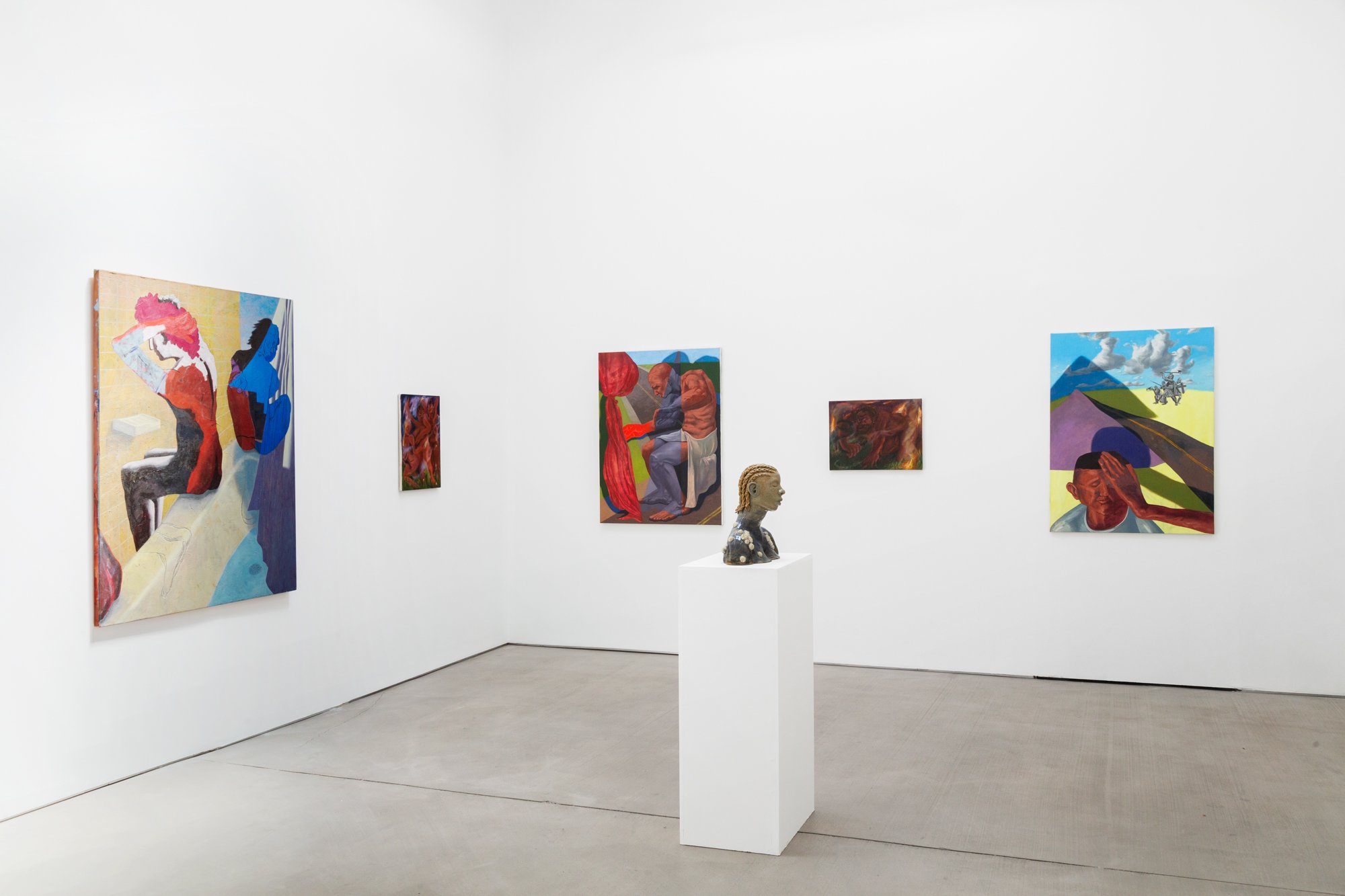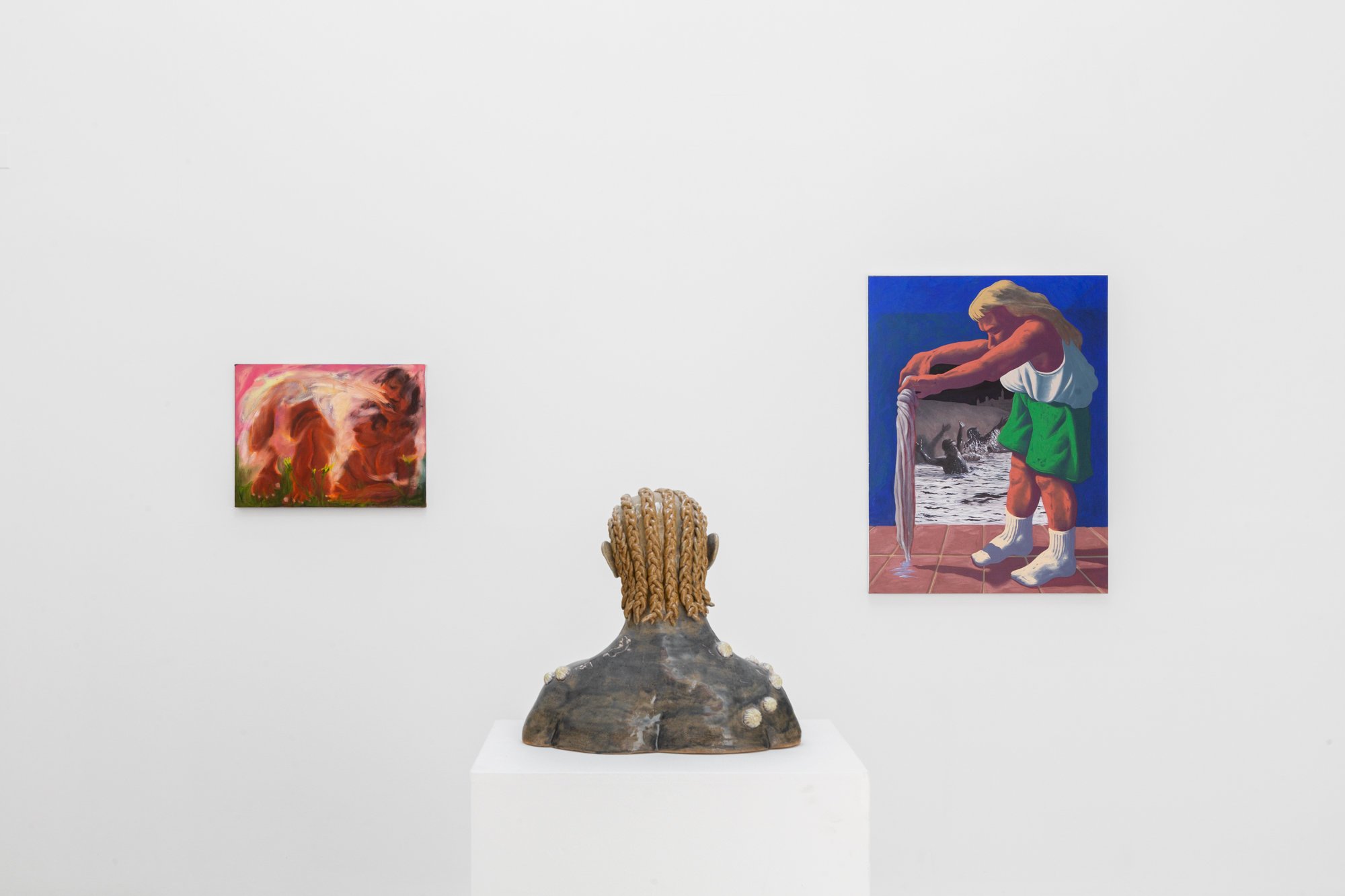JUNE PLATFORM PREVIEW
Featuring Whit Harris and John Denniston II
May 13th - June 17th 2023, PLATFORM Launch June 7th
Installation View, Photos By Daniel Terna
This month, in Gallery Space 3, you can also find the preview of our presentation of two brilliant artists who will be featured on PLATFORM for the month of June. The official presentation will launch June 7th on platformart.com and the works will be on view at the gallery until June 17th. Thank you to the team at PLATFORM and David Zwirner for featuring us again this year.
John Denniston II, Olympians: 1984, 2023, Oil and Acrylic On Canvas, 40 H x 30 W in
Denniston II’s ongoing series Double Illusions takes on philosopher Slavoj Žižek’s notion of the illusion as a real dimension of social activity. These oil paintings translate psychic structures, from nostalgia to neurosis, into classically illusionistic spaces. Flat planes of bright color merge with the delicate shading of early Renaissance style, and geometric shapes form surreal casts and shadows over more traditional brushwork. Solitary figures are then layered or suspended over landscapes in linear perspective, revealing and obscuring disparate scenes. Here, Denniston II employs curtains and dramatic lighting as motifs, presenting the contradictory theme at the heart of this series: the experience of life as a performance involving both “real” and “illusory” situations. His process is one that expresses invisible ideologies into a more present, structured light, while still paying dues to the aesthetic of illusion. Double Illusions offers a visual language for the relationship between current ideologies and their real-world effects, accounting for philosophical, literary, and art historical interpretations of the concept.
Installation View, Photos By Daniel Terna
Harris creates charged scenes of cultural disruption in her latest work, capturing transitive moments in which civilization dissolves into wildness. Having stripped them of their accouterments and danced them effusively in the grass, her figures convolute with the foreground. The artist imbues her canvases with movement through hazy and wild strokes of paint, blurring a sense of time passing and challenging the often-futile delineations of specific identity. Her characters then become avatars for the multifaceted expressions of the archetypal experience, often denying their roles within a hegemonic narrative in favor of more obscure, gestural, and uncanny portrayals. This series is one that addresses the dissonance between the influence of fixed social visions and the desire to break free from them in figurative painting. The detritus of crumbling empires are put to use, and Harris’ works take on a distinct change between an older era of materialism and a new age of ideas— imagining newer, more nebulous forms while reckoning with the ideological structures they have replaced.
Whit Harris, Rejoice! (In the Bounty of Our Pastoral Acquisitions), 2023, Oil and Acrylic On Canvas, 24 H x 18 W in
Whit Harris (b. 1985, Brooklyn) is a multi-disciplinary artist working across drawing, painting, and ceramics. Her work renders a dissolute experience of the human body through fluid, disjointed anatomies. Figures stretch, recline, wriggle, twerk and otherwise contort themselves in exaggerated expressions that oscillate between naturalistic and cartoonish forms, summoning the DuBoisian premise of “double consciousness” underlying contemporary Black identity. These reinvented bodies stand as metaphors for the artist’s psychological adaptation to unpredictable and hostile environments borne out of anti-Black social structures, working to incarnate the tenacity and ingenuity of Black femme imagination as a subversive means of political resistance.
Installation View, Photos By Daniel Terna
John Denniston II (b.1999, California) uses oil paint as a medium to improvise within realistic picture-making structures. By staging scenes of chaotic abstraction from classic formulas, he challenges the ideological implications founded in historic painting practices, opening within them a surreal scene of figurative possibilities. The manipulation of linear perspective and color temperature instill his canvases with a sense of spatial contradiction and narrative disarray, and become disruptions through which Denniston II offers criticism on topics of the Enlightenment and other 20th century catastrophes. In taking on the discourses of philosophy and anthropology with an artist’s introspection and imagination, he pressures the ability of paint to evoke the conceptual out of the formal, generate new commentaries, and lighten the weight of burdensome logic.
John Denniston II, Sheer Drape, 2023, Oil and Acrylic On Canvas, 48 H x 36 W in







